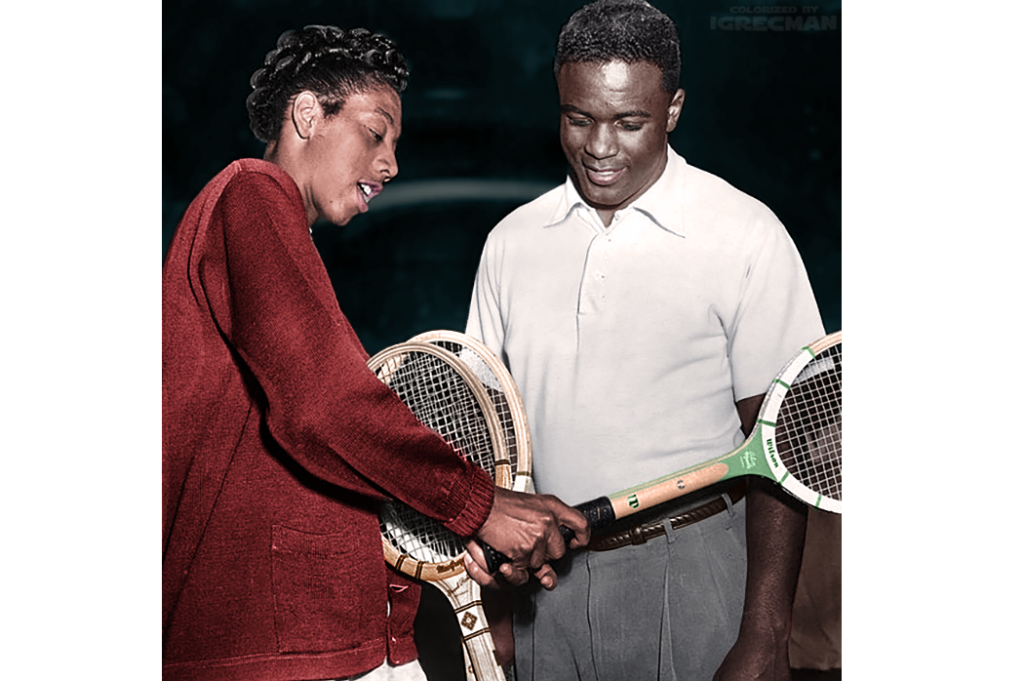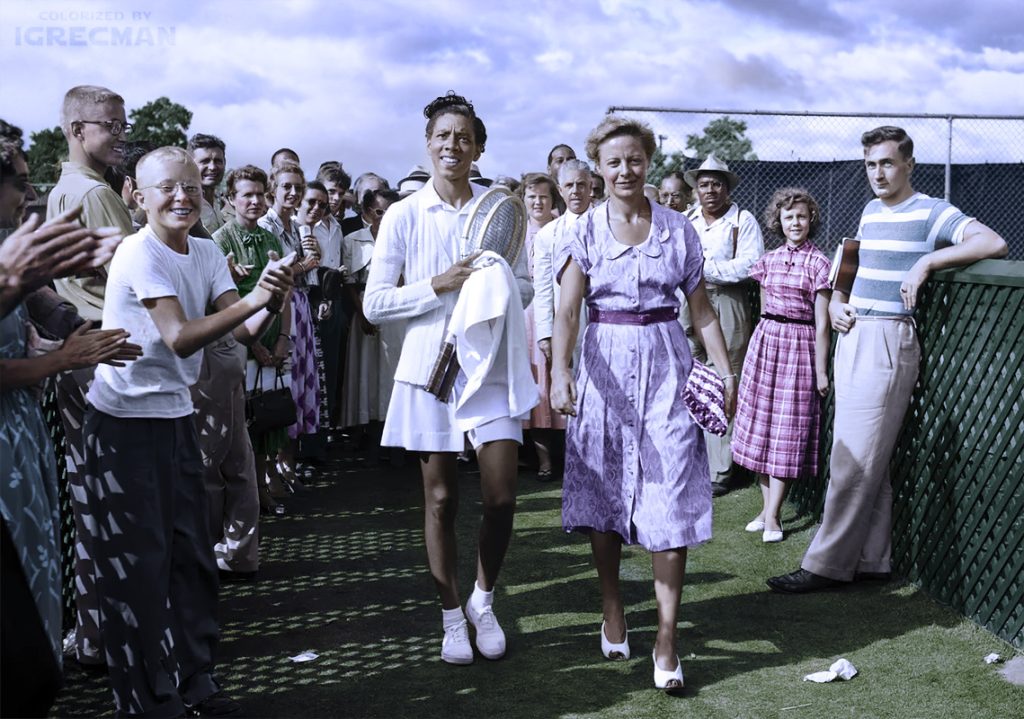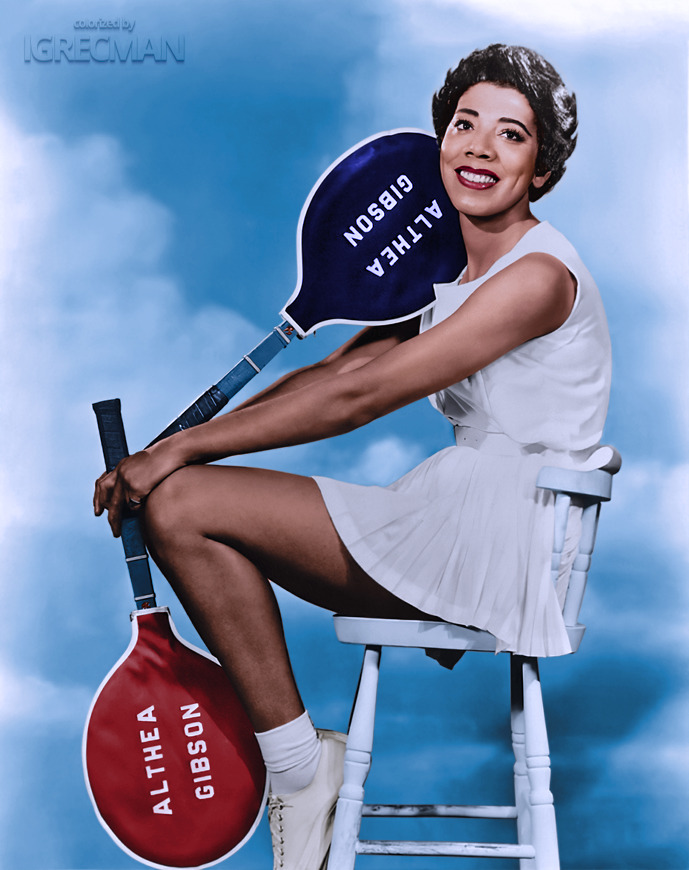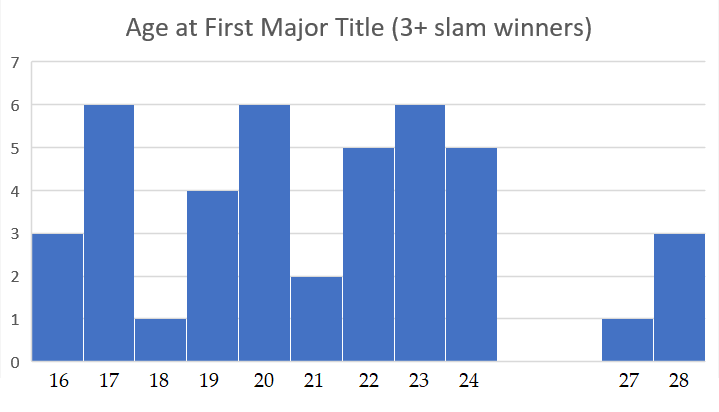
Colorization credit: Women’s Tennis Colorizations
In 2022, I’m counting down the 128 best players of the last century. With luck, we’ll get to #1 in December. Enjoy!
* * *
Althea Gibson [USA]Born: 25 August 1927
Died: 28 September 2003
Career: 1946-60
Played: Right-handed (one-handed backhand)
Peak rank: 1 (1957)
Peak Elo rating: 2,386 (1st place, 1957)
Major singles titles: 5
Total singles titles: 74
* * *
Since the end of World War I, 42 women have won three or more grand slam titles. The list runs the gamut from Suzanne Lenglen, who picked up her first in 1919, to Iga Świątek, who recorded her third victory a few weeks ago.
The average age of these superstars at the time of their first major title was 21 and a half. One in three scored their first championship when they were still in their teens. Only four were still slamless on their 27th birthday: Althea Gibson, Angelique Kerber, Margaret Osborne duPont, and Hilde Sperling.
Here’s a histogram of the age distribution, from the trio of 16-year-old first-timers to the lonely quartet of 27- and 28-year-olds:
Beginning a multi-slam career, clearly, is a young woman’s game. In one way, this is obvious. If you win a major as a teen, you have a decade or more ahead of you. In the amateur era, that might have meant 20-plus chances to win more. Today, with players entering all four slams each year, it could mean 40 or more bites at the cherry.
We can also look at this in the reverse direction. If you are the type of player who will be capable of winning a major when you’re 28, you’ll probably peak earlier–often much earlier. Plenty of women in both the amateur and Open eras have won majors at age 28 and beyond, but they are typically the same stars who racked up titles earlier in their careers.
If you manage to win three slams despite starting at such a late age, you’ve defied the aging curve. There’s often an external factor that serves as an explanation. Osborne didn’t win a major until 1946, in part because World War II limited her to one chance per season for six years before that. Sperling started late, and she wasn’t helped by Germany’s exclusion from international tennis after the first World War. She didn’t play a major until she was 21, and her first Wimbledon entry was a year after that. Kerber was just a late bloomer; she’s one of many 21st century stars to challenge the notion that tennis is a young woman’s game.
That leaves Althea Gibson. She played her first major at Forest Hills in 1950, just as she turned 23 years old. She went to Wimbledon the following year, but didn’t make her second trip until 1956, when she was 28. She entered only 15 slams in her entire career, more than half of them after her 28th birthday.
She was a late bloomer, yes. But calling her that is a bit like blaming a dying plant when you forget to water it.
Gibson, a Black woman born in the American South, pried open the doors of racial segregation in tennis at the US National Championships in 1950. Six years later, she reached the Forest Hills final; a year after that, she was the Wimbledon and United States champion and the undisputed best player in the world.
Compared to the fate of the Black players who preceded her, such as Ora Washington, Althea’s career was an unadulterated triumph. She broke new ground for her race nearly every time she stepped on court, ultimately changing the course of American tennis. But compared to what might have been, Gibson’s five major titles and her two- or three-year run at the top are just glimpses of what was possible.
As I’ve said, if a player is capable of winning a major at age 28, they were probably just as good, if not better, years earlier. Althea wasn’t, through no fault of her own. Any analysis of her accomplishments needs to keep in mind that, long after she integrated tennis, the segregated history of the sport severely handicapped her progress.
Gibson is one of the game’s all-time greats. Yet she could have–should have–achieved even more.
* * *
Young Althea started winning tournaments almost as soon as she picked up a tennis racket. She grew up in Harlem, where the local Police Athletic League gave her a taste of a variety of sports. She played paddle tennis from a young age, then fell in love with basketball. She only held her first full-size racket when she was 13.
She won her first tennis trophy when she was 14. In 1944 and 1945, she scored national junior titles at American Tennis Association (ATA) events–the unofficial championships of Black Americans. It was a smooth transition from there to the adult division of the Black game. In 1946, she won two regional events and reached the final of the national tournament, narrowly losing to veteran Roumania Peters.
Gibson in 1950
As a 19-year-old, Gibson established herself as the best player of her race. She played a circuit of six tournaments and won the lot. While the existing records don’t cover every early-round match, there’s no evidence she lost as much as a single set. In another meeting with Peters for the 1947 national championship, she got her revenge, 7-5, 6-0.
She would play the ATA nationals every year until 1956. No one ever beat her there again.
It’s worth taking a step back here and considering the effect of her skin color on the budding star. The USLTA–the governing body of (white) tennis in the United States–was always on the lookout for prospects. Local associations would raise money to send promising teens to the national junior tournament in Philadelphia. Tournament organizers at Forest Hills liberally handed out entries to teens with little experience. Most of the youngsters crashed out early, but that wasn’t the point. Pooh-bahs of the tennis establishment got a look at the rising talent, and up-and-comers gained from the experience.
Gibson benefited from none of this. The pipeline was reserved for white girls.
Althea did have her supporters. Local sponsors in Harlem paid for her first lessons. A pair of patrons, Dr. Robert Walter Johnson and Dr. Hubert Eaton, helped her complete her education and get to tournaments beyond easy commuting distance. Johnson, Eaton, and promoters of the Black game such as Arthur Francis are unsung heroes of the integration story. They assiduously scouted for and developed the talent that could knock down the color barrier. Without them, American tennis would’ve been whites-only for another decade or more.
The one thing that Black supporters couldn’t do for Gibson was arrange matches with high-quality white opponents. Shirley Fry, an excellent junior player from Ohio, was just a few months older than Althea. In 1947, the year that the young Black star won her first ATA title, Fry made her seventh appearance at Forest Hills. When the color barrier finally came down, Gibson had a lot of catching up to do.
* * *
It’s remarkable, then, just how quickly Althea proved herself capable of competing at the highest level.
Dr. Reginald Weir became the first Black entrant at a major USLTA event in 1948, when he competed at the National Indoor tournament in New York. Althea followed a year later, winning matches at both the Eastern Indoor Championships and the National Indoor event in 1949. That was the extent of her welcome; she didn’t play another USLTA tournament until the following year.
In 1950, it was clear she belonged. She won the Eastern Indoors, progressing past five solid regional players without the loss of a set.* A month later, she finished runner-up at the National Indoors to Nancy Chaffee, a strong Californian who would be ranked fourth in the world a year later.
* Althea’s first-round opponent at the Eastern was Veronika Katilius, a former Lithuanian champion who had fled her Soviet-occupied homeland just a few months earlier. Katilius would later coach a young Vitas Gerulaitis.
That summer, thanks in large part to the lobbying of former champion Alice Marble, Gibson was finally invited to play at Forest Hills. The national tournament was played on grass, presenting another challenge beyond the unfamiliar opponents and the gawking crowds. Sarah Palfrey offered Althea a crash course in grass-court play. Palfrey noticed that the five-foot, eleven-inch young woman struggled to get down to low balls, but “[h]er natural timing and big, catlike strides were useful for the faster pace of a grass court.”

Colorization credit: Women’s Tennis Colorizations
Louise Brough would soon discover the same thing. Althea won her first match at Forest Hills easily, setting up a second-rounder with Brough, the reigning Wimbledon champion. Both women struggled with nerves as they split the first two sets. Gibson grappled with the pressure and the packed grandstand court, Brough with the realization that the newcomer might get the better of her. They settled into a third-set slugfest that many onlookers thought Althea would win. Stormy weather halted their progress with Gibson leading, 7-6 in the third.
These days, a player with a suspended match would race back to the clubhouse, hide from reporters, and switch on Netflix to zone out until the next day’s resumption. The old Forest Hills venue left players particularly exposed, and Althea was besieged. She came back the next day as nervous as she had been at the start of the match. Still, after Brough equalized for 7-all, Gibson fought through five deuces before conceding her own serve. The Wimbledon champ secured her victory, 6-1, 3-6, 9-7.
Outcome aside, it was clear that American tennis had a new star. It would take six long years for her to realize her full potential.
* * *
Althea posted a respectable sophomore campaign in 1951. Balancing tennis with her studies at Florida A&M University, she won five titles and got her first taste of European tennis.
Still, her results pointed back to the match experience she had missed in her early years as the queen of the Black tournament circuit. Against second-rate white competition, she never lost. Faced with a top-tenner, she barely stood a chance. She lost to Chaffee again at the National Indoors, and she dropped decisions elsewhere to Fry, Doris Hart, and Beverly Baker Fleitz. On the American grass-court circuit, she had the misfortune of running into the fast-rising Maureen Connolly–twice.
The 41 matches Gibson played in 1951 were the closest she would come to a full season until 1956. Her attempt to belatedly climb the ladder of American tennis exposed a vicious circle of the amateur era. To improve, you needed match play. To become match-hardened, you needed to go where the top players were competing. To get there, you had to have a high ranking… or some alternative source of financial support. The USLTA wouldn’t bankroll more of Althea’s travel until they thought her results justified it. (And, presumably, they held her to a particularly high standard.) The money wasn’t coming from anywhere else.
Lester Rodney was a journalist who covered the Black stars of integration-era baseball. He wrote of Gibson’s first appearance at Forest Hills, “In many ways, it is even a tougher personal Jim Crow-busting assignment than was Jackie Robinson’s when he first stepped out of the Brooklyn Dodgers dugout.”
Rodney was referring to the loneliness of a single competitor representing her race for the first time in an individual sport. Indeed, “lonely” is a word that comes up again and again in descriptions of Althea’s time on the circuit.
But once the color barrier was down, Gibson’s real challenge was structural, not psychological. She had to pay the bills, and the amateur-era establishment did little to help. Jackie Robinson at least got a regular paycheck. The USLTA held to a stricter definition of professionalism than other national federations, so the usual workarounds–endorsements, no-show jobs, etc–weren’t allowed. Top male players might land a flexible gig with a tennis fanatic for a boss. But in the 1950s, women who hoped to take time off for tournaments were generally stuck temping in a secretarial pool.
So Althea finished her degree, found a job at Lincoln University in St. Louis, and played a few tournaments every summer. By 1955, she was ready to quit tennis entirely.
* * *
It’s a good thing she stuck with it. A State Department tour through Asia in the winter of 1955-56 launched Gibson on one of the most extraordinary breakout seasons in history.
She played her way through Southeast Asia, India, and Pakistan, befriending her future doubles partner, Angela Buxton. The tour left her in Europe in time for the winter indoor season. In Stockholm, Cologne, Paris, and Lyon, she won three tournaments and 12 of 13 matches (at least–records may not be quite complete), easily handling the best competition on the Continent. The only woman who could beat her–the only opponent who would do so for months–was a stubborn Brit, Angela Mortimer.
When the circuit shifted to clay courts, Gibson was even better. After dropping a pair of finals to Mortimer in Egypt, she won seven straight tournaments on dirt. The streak culminated in her first major championship, a victory at Roland Garros, where she finally turned the tables on her British tormentor. She defeated Mortimer in the Paris final, 6-0, 12-10.

Colorization credit: Women’s Tennis Colorizations
By now, she was impervious to surface. Althea won the first three grass-court events she played in Britain, knocking out Shirley Fry and Louise Brough in back-to-back matches at the Northern Championships in Manchester. She entered Wimbledon on a 44-match win streak.
Her next seven months were even better. Between Wimbledon and the Australian Championships in January 1957, Gibson won 70 of 75 matches. She claimed titles–ten of them–on three continents. The only obstacle standing behind Althea and total world domination was Shirley Fry, the unassuming retriever who had a knack for absorbing power and grinding out tough victories. All five of Gibson’s losses in that span came against Fry–at Wimbledon, Forest Hills, and the Australian Championships.
* * *
I suspect that Althea would’ve soon figured out how to beat Fry. As it turned out, she didn’t have to. On the Australian trip, Shirley met her husband-to-be, got pregnant, and retired from tennis.
With Fry out of the picture, Gibson towered over the field to an extent that hadn’t been seen since the reign of Alice Marble in the 1930s. After the 1957 Australian final, she didn’t lose another match for the entire season. She defended her titles in England and cruised to her first Wimbledon championship without dropping a set. The young British hope Christine Truman managed just two games in the semi-final. Darlene Hard won only five in the final.
Back home, Althea sent Louise Brough into retirement as well. The two women met in four finals, and Gibson won the lot. Brough’s fearsome kick serve always threatened to keep things close, but when the stakes were high, Gibson simply dominated. She beat Louise for her first Forest Hills final, 6-3, 6-2. At the Pacific Southwest in Los Angeles a month later, she won the title match, 6-3, 6-1.
1958 was just as good. After a few blips on the Caribbean circuit–Althea lost two decisions to Janet Hopps and a third to Beverly Baker Fleitz–she was unbeatable once again. Between May and August, Gibson won 33 straight matches. She defended her Wimbledon and United States crowns, conceding just three sets in a four-month span.
When she won the 1958 Forest Hills title, Gibson had just turned 31 years old. She would finish the year as the world number one for the second straight year–third, if you go by my historical Elo ratings. She had broken every barrier there was to break in her sport.
* * *
Had she continued competing on the amateur tour, the reigning number one probably could’ve doubled her career total of five majors–at least. The years immediately after she stepped away were something of a transition period. Maria Bueno was the only star who might have challenged her before Margaret Smith (the future Margaret Court) came along in the early 1960s.
But after her 1958 triumphs, Althea was ready to move on. She told Sarah Palfrey the year before, “Let’s face it: I’ve gotta make good while the iron’s hot.” She had seen her fellow 1957 Wimbledon champion, Lew Hoad, sign a pro contract worth $125,000. She knew the bleak history of women’s professional tours, but she felt it was time for conquests that could be measured in dollars.
After playing (and winning) the 1959 Pan-American Games in Chicago, Gibson went pro. She wrote a book, went to Hollywood, tried her hand at acting, and released an album of jazz standards. She signed on for the inevitable barnstorming tour, playing against Karol Fageros as the opening act before Harlem Globetrotters basketball games. Fageros was better known for her looks than her tennis skills, and Gibson won 114 of their 118 meetings.
There never were any suitable job openings for a retired Black woman tennis star. Gibson joined the pro golf tour, breaking more racial barriers and setting the occasional course record, though she never approached the top of the world rankings. She wrote another memoir and attempted a couple of tennis comebacks when the professional and amateur games merged in the Open era.
Althea was, in so many ways, born too soon. Around the age that Gibson finally reached the apex of the game, most of her white peers on the circuit retired to get married, raise families, and perhaps coach a little tennis on the side. That was what was expected of them, and after their youthful forays into competitive sport, that was what they did.
Gibson had to fight for a right to play on the circuit. She struggled for years to get enough competitive match play to reach her potential. Having achieved everything an amateur tennis aspirant could hope for, she found herself back at square one, searching for a place in a world that didn’t quite know what to make of her.
It might have been little consolation to Althea in 1959, but her struggles made so much possible, for both Black stars and women athletes in general. While she never got a proper sendoff at Forest Hills herself, there’s a direct line running from her own accomplishments in the 1950s to the Serena Williams retirement party that defined the 2022 US Open.
* * *
Previous: No. 43, Guillermo Vilas
Next: No. 41, Doris Hart
Subscribe to the blog to receive each new post by email:
